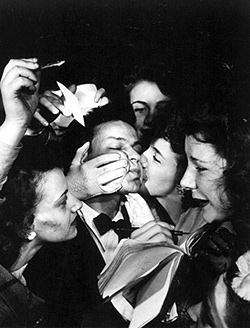The clip was from High Society (1956). The film stars Bing Crosby as C.J. Dexter-Haven (aka Dexter), a jazz cat trying to win over his ex-wife and neighbor Tracy Lord, the lovely Grace Kelly. Our pal Frank Sinatra also stars in the film as Mike Connor, an undercover tabloid journalist who becomes attracted to Tracy while covering her wedding to businessman George Kittredge, played by John Lund. The plot erupts into a sort of love-square, or a triangle with Kelly at the center.
A few observations:
--The film's portrayal of Crosby as a jazz musician is odd, considering the presence of Louis Armstrong and his band. Crosby doesn't do anything particularly jazzy, other than sing in his normal crooner style. The "Now You Has Jazz" number is really quite vanilla--a comfortable introduction to the dangerous, outsider world of jazz music for the stuffy gala crowd. Considering the prevailing trends in jazz music at the time of the film's release, the number in High Society is a bland swing composition. In the mid-1950s, jazz had transitioned from the familiar, approachable Benny Goodman-type big band dance arrangements to the esoteric, challenging styles of bebop, cool jazz, and hard bop. In 1956, anyone familiar with the jazz scene would have already heard the work of John Coltrane, Miles Davis, Thelonious Monk. "Now You Has Jazz" is friendly--it is, appropriately, Bing Crosby-style jazz.
--Sinatra and Crosby aren't set at odds as crooners in High Society. They have one number together, a delightfully silly drunken duet. Crosby establishes himself vocally early in the film--he has the first musical number. It makes sense for his character to be singing. After all, Dexter is a jazz musician. The backstory is that Dexter wrote a song called "Samantha" as an ode to his young wife Tracy. When Sinatra sings, it's a little more incongruous. Tabloid journalists aren't supposed to have pipes like that!
--Sinatra seems like the third-tier musician in the film. Crosby wins, I think because his character is a musician and he can sing. But for me, Louis Armstrong beat Sinatra for the second spot. Armstrong plays himself in a very odd narrator role. He opens the film in a bus with his band, singing the "High Society Calypso," a prologue for the film. Throughout, Armstrong pops in and comments on the action and progress of the narrative. Armstrong validated Crosby as the primary musical character by providing accompaniment for Crosby's first song. Crosby sings to Caroline Lord in the garden, and a few bars into the song, the camera pans the yard as Crosby strolls around. When Crosby walks past an open door, we see Armstrong inside, playing the accompaniment for the song with his band. This little detail makes Crosby's performance much more believable and realistic. When Sinatra sings, he doesn't have any visible accompaniment, so it feels much more like a movie or a Broadway show.



